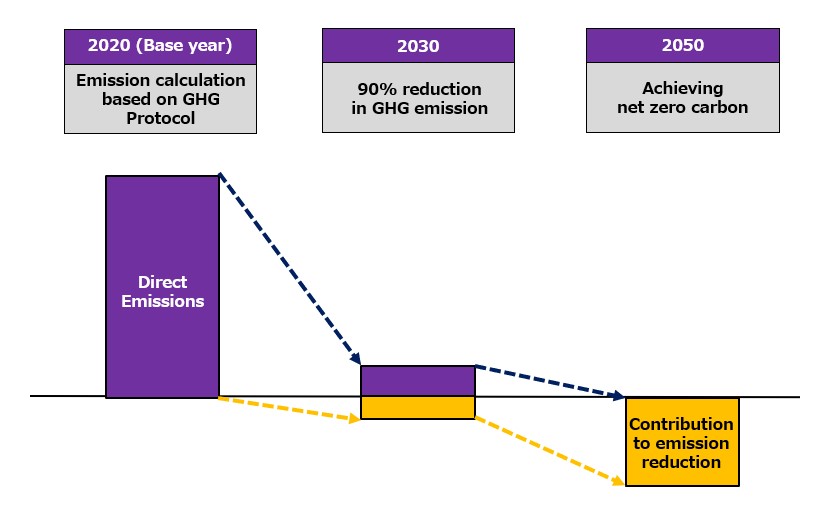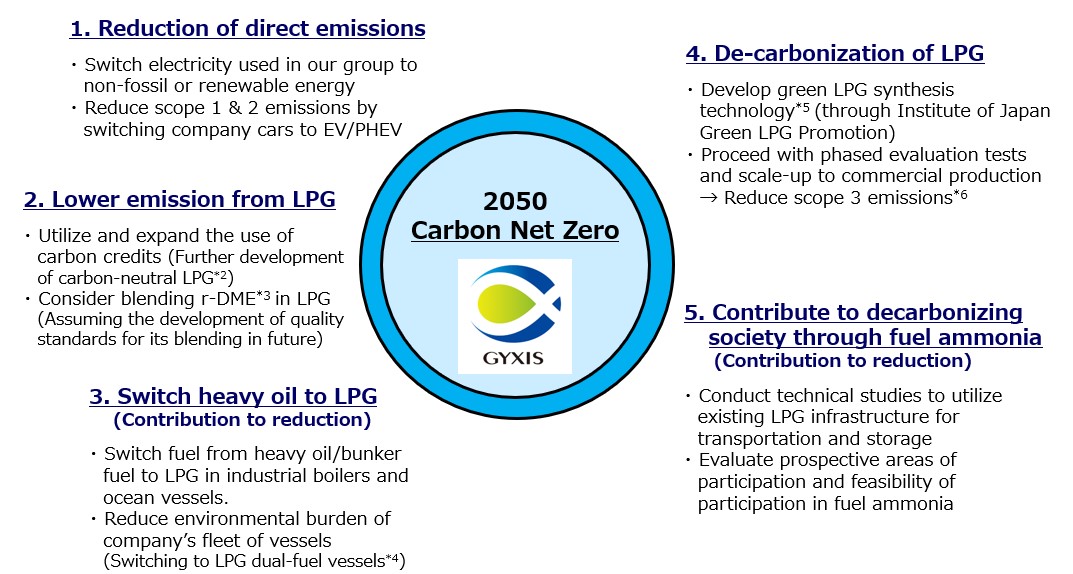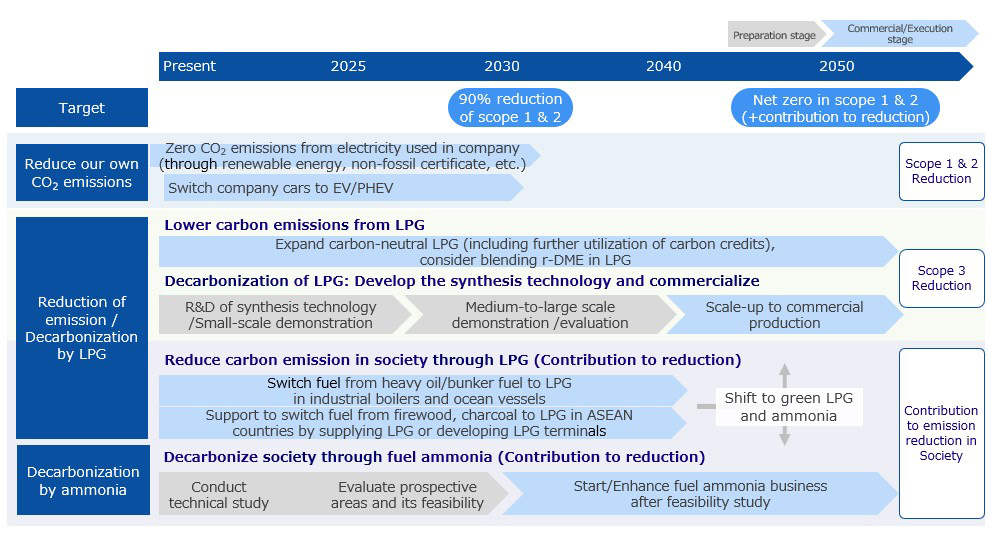While fulfilling our responsibility of providing a stable energy supply, we aim to reduce 90% of direct GHG emissions (scope 1 & 2)*1 from our own operations by 2030 (compared to FY2020) and achieve carbon net zero by 2050 by introducing non-fossil electricity and promoting fuel switching etc. in our group.
Furthermore, we will undertake initiatives to develop green LPG to achieve carbon neutrality as well as make efforts to reduce GHG emissions throughout society (also called a “contribution to emission reduction in society”), including our initiatives of promoting fuel ammonia, in addition to reducing our direct GHG emissions, in order to achieve a carbon-free society by 2050.
*1 Scope 1 & 2:
They are categories of Greenhouse Gas (GHG) emissions based on GHG Protocol,
which has been globally adopted as a standard for the calculation of GHG emissions.
- Scope 1: GHG emissions directly from the company’s business operations and activities.
- Scope 2: GHG emissions from the use of electricity, heat, or steam provided by other companies.
Liquefied Petroleum Gas (hereinafter “LPG”) is an environmentally-friendly low-carbon energy source that is portable and can be stocked without deteriorating in quality.
We believe that LPG plays an important role in the transition period of a lower carbon society before achieving a carbon-free society, in addition to the strong point of resilience to disasters.
We launched “carbon-neutral LPG,” which combines LPG with high-quality voluntary carbon credits in 2022. We will continue to make efforts to expand the use of carbon-neutral LPG in order to support our customers’ requirements for carbon neutrality.
Furthermore, we will endeavor to switch fuel from heavy oil/bunker fuel to LPG in industrial boilers and ocean vessels etc. in addition to our initiatives to reduce the direct GHG emissions in our group.
From a long-term perspective, we aim to develop green LPG synthesis technology through the “Institute of Japan Green LPG Promotion” established in 2021 and, furthermore, plan to scale-up production to make green LPG commercially viable. We will also contribute to achieving a carbon-free society by pursuing our expected role in the supply chain of fuel ammonia, which is expected to be used as a material for co-firing with coal in coal-fired power generation and as a non-fossil marine fuel for ocean vessels, through utilizing our infrastructure and experience of LPG importation, storage and transportation.
*2 Carbon-neutral LPG:
It is LPG that offsets the estimated GHG emissions over the whole value chain from its production to its consumption by end users of LPG through voluntary carbon credits certified by a carbon-credit certification organization.
*3 r-DME:
DME is the abbreviation of Di-Methyl Ether. It has similar properties to LPG and lower CO2 emission per heating calorie. There are evaluation results showing that DME can be possibly used as a supplementary material for LPG without any change in existing gas equipment and facilities at a certain mixing ratio for DME and LPG. Renewable-DME (r-DME) is DME produced using biomass, industrial waste, etc. as its feedstock.
*4 LPG dual-fuel vessels:
They are ocean vessels that can use both LPG and bunker fuel as fuel. They are environmentally-friendly vessels that are expected to reduce emissions which cause global warming and air pollution, reducing approximately 20% of carbon dioxide (CO2), 90%–100% of sulfur oxide (SOx) and 10%–15% of nitrogen oxide (NOx) when operated with LPG versus conventional heavy oil/bunker fuel.
*5 Green LPG:
It is LPG that is synthetically produced from CO2 and green hydrogen or biomass-derived r-DME. It absorbs CO2 in the synthesis/production of green LPG and is considered as carbon recycle.
*6 Scope 3 emissions:
They are indirect GHG emissions in the supply chain except the scope 1 & 2 portions based on the GHG Protocol.
In line with our goal for GHG emission reduction, the chart below is a planned roadmap for our main initiatives of “Reducing of the company’s direct GHG emissions,” “Lowering LPG carbon emissions,” “Decarbonization of LPG,” and “Contributing to a carbon neutral society with fuel ammonia.”
We will undertake initiatives to develop green LPG and fuel ammonia step-by-step from a long-term perspective. We are simultaneously working on further development of carbon-neutral LPG and switching fuel to LPG in ocean vessels and industrial boilers etc. in the short and medium term. We aim to eventually connect this to implementing green LPG in society.
New frameworks and regulations, which are not currently anticipated, may be introduced to achieve a carbon neutral society in future. In such cases, we will consider revising our goals and roadmap to be in line with the latest business circumstances and environmental regulations.





